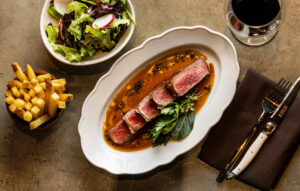 Somewhere, in a squat little cardboard tube, lies a row of Pillsbury dinner rolls, mashed into one another as if caught in some evil baker’s version of airline seats, and each of those rolls, as it pays its Karmic debt to the gods of flour and water, thinks of one thing only: Please, please let me come back as a Parker House roll, baked from scratch in somebody’s kitchen, pulled apart by the chubby little fingers of happy little children. At least that’s what comes to mind as I pull these puffy, golden little pillows from the oven, our entire home smelling sweetly of toasty yeast and melted butter, my kids bouncing up and down like Chanukah and Christmas came early this year.
Somewhere, in a squat little cardboard tube, lies a row of Pillsbury dinner rolls, mashed into one another as if caught in some evil baker’s version of airline seats, and each of those rolls, as it pays its Karmic debt to the gods of flour and water, thinks of one thing only: Please, please let me come back as a Parker House roll, baked from scratch in somebody’s kitchen, pulled apart by the chubby little fingers of happy little children. At least that’s what comes to mind as I pull these puffy, golden little pillows from the oven, our entire home smelling sweetly of toasty yeast and melted butter, my kids bouncing up and down like Chanukah and Christmas came early this year.
I distinctly remember eating dinner rolls as a child: The milky sweetness of a just-the-right-side-of-doughy, slightly flaky interior; the barely perceptible crackle of soft buttery crust; the slight resistance when I pull one free from its litter; they way a fine dinner roll can overshadow whatever it was meant to accompany. Still and all, I’m not even sure if these Proustian rolls from my youth were actually baked by my mother, served alongside the 1970s incarnation of the Smorgasboard buffet my brother and I always chose for special occasions, or merely intuited by way of the iconic dough-boy in the ads, a televised osmosis, a little dose of kiddie SOMA baked directly into the memory banks. Does it even matter? I remember them, all the same.
Whether these particular rolls qualify as true Parker House rolls – named for the Parker House Hotel in Boston, where they are still served – is an open question. If you like to bet on celebrity chefs, you can find versions by Martha Stewart, Bobby Flay, and Tom Colicchio; if historical accuracy is your thing, you can even find a credible printed recipe from 1896. Regardless, this is what I know, as of 6pm last night: I am not a baker, and even I can make a spectacular version of these rolls. And they are that thing of rare beauty, a little nugget of white-trash loveliness that will make you a hero to your children, transform grown men into little boys, and generally restore one’s faith in one’s oven. So please, make these rolls. And do let me know if you find a better version?
Parker House Rolls (Adapted from T Colicchio, as printed in Saveur)
Note: I’m pretty sure that the printed version is incorrect (read the comments or, worse, try it yourself; the main flaws are too cool an oven and too short a proof, although I’m not convinced about his precise quantities, either), so I’ve reprinted their version, crossing out the original wherever I’ve made changes, with my reasoning (in parentheses); another home cook’s take may be found here.
Chef Tom Colicchio’s fluffy, buttery dinner rolls may be the best we’ve ever eaten. The secret? Barley malt syrup, a molasses-thick liquid sweetener that adds a hint of malty flavor.
 1. Stir together milk, yeast, and malt syrup honey in a large bowl; let sit until foamy, 10 minutes. In a medium bowl, whisk together flour and salt; add to milk mixture along with butter and stir with a wooden spoon until a dough forms. Transfer to a lightly floured work surface and knead until smooth, 5–6 minutes. Transfer dough to a lightly greased bowl and cover with plastic wrap; let sit until nearly doubled in size, about at least 1 hour. Uncover and punch down dough; cover and let sit until puffed, about 45 minutes rest for 10-15 minutes (we’ll get all the rise from a much-longer proof).
1. Stir together milk, yeast, and malt syrup honey in a large bowl; let sit until foamy, 10 minutes. In a medium bowl, whisk together flour and salt; add to milk mixture along with butter and stir with a wooden spoon until a dough forms. Transfer to a lightly floured work surface and knead until smooth, 5–6 minutes. Transfer dough to a lightly greased bowl and cover with plastic wrap; let sit until nearly doubled in size, about at least 1 hour. Uncover and punch down dough; cover and let sit until puffed, about 45 minutes rest for 10-15 minutes (we’ll get all the rise from a much-longer proof).
 2. Heat oven to 325°350F (check your oven temp – this is a little delicate). Portion dough into (about) fourteen 1 1/2″-diameter balls, about 1 1/4 oz. each, and transfer to a greased 8″ cast-iron skillet or 8″ x 8″ baking pan, nestling them side by side (you want a little space between them), and brush them with butter; cover loosely with plastic wrap a damp cloth and let sit until doubled in size, about 2 hours about 4-6 hours; you may have to slow it down by putting the pan in the fridge for the first 2-4 hours, but but sure to take it out at least 2 hours before baking to allow the dough and the metal to come to room temperature. Brush again with clarified butter, and bake until puffed and pale golden brown, 20–22 about 25 minutes (check at 20, and keep an eye on them). Transfer to a rack and brush with more clarified butter; sprinkle each roll with a small pinch of fleur de sel and serve warm.
2. Heat oven to 325°350F (check your oven temp – this is a little delicate). Portion dough into (about) fourteen 1 1/2″-diameter balls, about 1 1/4 oz. each, and transfer to a greased 8″ cast-iron skillet or 8″ x 8″ baking pan, nestling them side by side (you want a little space between them), and brush them with butter; cover loosely with plastic wrap a damp cloth and let sit until doubled in size, about 2 hours about 4-6 hours; you may have to slow it down by putting the pan in the fridge for the first 2-4 hours, but but sure to take it out at least 2 hours before baking to allow the dough and the metal to come to room temperature. Brush again with clarified butter, and bake until puffed and pale golden brown, 20–22 about 25 minutes (check at 20, and keep an eye on them). Transfer to a rack and brush with more clarified butter; sprinkle each roll with a small pinch of fleur de sel and serve warm.
MAKES ABOUT 14 ROLLS









